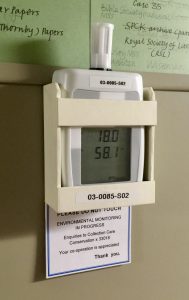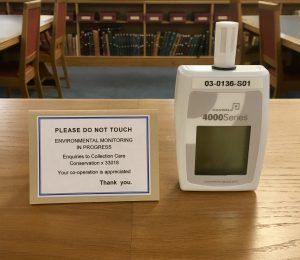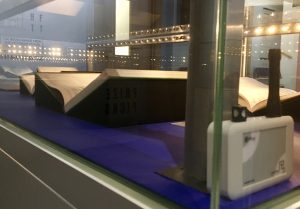Keeping Our Cool: Environmental Monitoring at the Library
What do you consider lovely, comfortable weather? Maybe you’re picturing a clear day with temperatures in the mid-twenties, a nice cool breeze coming in, and dry enough not to be muggy but with enough humidity to keep your skin happy. There may even be a cold margarita in this vision to cool you down from a couple of toasty hours in the sun.
Unfortunately, perfect human weather does not look very much like perfect book weather. Books prefer the cool, dark, and dry environments found in climate controlled Special Collection storage, and do not enjoy cocktails. It’s common knowledge for the University Library’s regular readers that the care and keeping of books involves careful handling while the book is being used, but it is the job of the UL Collection Care Team to keep the books safe when they have been returned to the shelves.
One of the main ways this is accomplished is by the careful and comprehensive monitoring of the temperature and humidity in the areas where the Special Collections are being stored and displayed. Keen observers will note the small, unobtrusive devices sitting in the corners of display cases and mounted on walls in the main entrance and reading rooms. These monitor the environment in the cases and the storerooms and provide a wealth of data for the Collection Care Team to use to determine if each area is a safe place for its charges.
Perfect book weather at the UL is defined as a temperature between 15 and 20 degrees Celsius, with a relative humidity of 40-60%. Because manuscripts and rare books are often made entirely of organic materials such as parchment, leather, wood, and natural fibre paper and textiles, they are particularly susceptible to changes in the moisture content of the air around them. These materials absorb and release water content in much the same way they did as living skins and plants, and expand and contract depending on the humidity level. Because or this, constant changes in the level of moisture they encounter will cause these materials to microscopically expand and contact. High humidity encourages mould growth, and low humidity can cause dryness and cracking. Too many extreme fluctuations between the two over a book’s lifetime can cause these materials to warp, split, or flake away.
So next time you look into one of our display cases or peruse a rare book or manuscript in our Reading Rooms, take notice of those little devices. Though they are quiet and small, they do invaluable work!



